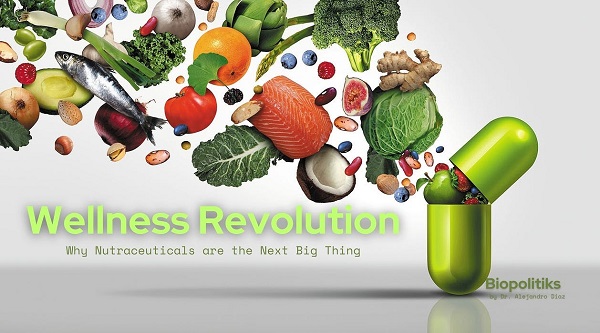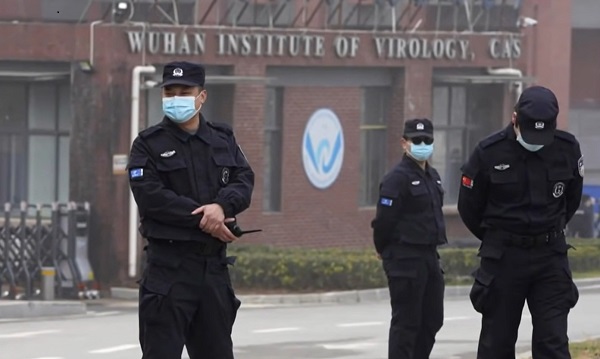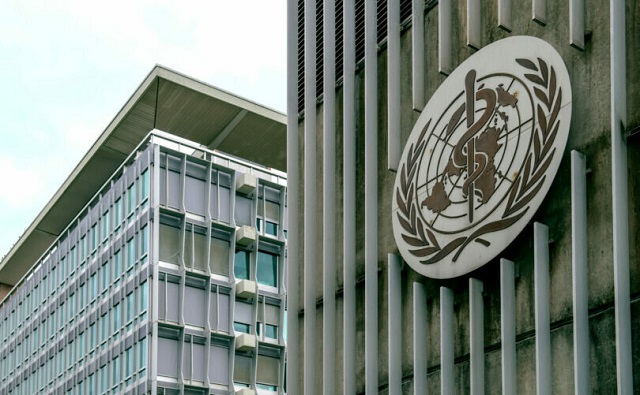Health
Wellness Revolution

|
|
From Courageous Discourse
Why Nutraceuticals are the Next Big Thing
The New Health Conscious
The revival of health consciousness that has taken place in this decade has changed the way the general public views healthcare—forever. The COVID Operation put health back into the conversation. This elevation in the collective health consciousness has led to a Wellness Revolution, worldwide.
Patients now understand the reality of the state of healthcare systems. The fact is that we are a highly medicated and highly vaccinated society, and the truth is that as the use of these products has increased, so has disease prevalence.
If we take more vaccines and more medications than ever before as a society, shouldn’t we be healthier than ever? Unfortunately, this isn’t the case. The global population is sick and only getting sicker; the toxic injectable products, gene therapy, so-called “COVID Vaccines” made sure that people become permanent clients of the sick-care industrial complex.
A stellar example of this phenomenon is the United States. The United States makes up around 4% of the world’s population, yet it represents around 64 to 78 percent of global pharmaceutical profits. This should mean that Americans are the healthiest in the world by far, right? Unfortunately, no. The United States leads the world in chronic disease prevalence and has a significantly lower life expectancy than most other developed nations.
The current system is fraudulent. People are taking notice of this fraud. In protest, they are looking for alternatives to traditional medicines for disease care. One of the emerging therapeutics in this realm is nutraceuticals.
Nutraceuticals are foods or elements of food obtained from plant or animal origin with significant medical or health benefits utilized to prevent or cure diseases. The medicinal use of food or food elements derives from the beginning of modern medical understanding. Hippocrates is famous for his remarks on this issue. He states, “Let food be thy medicine and medicine be thy food.”
As an allopath (Pediatric Allergist/Immunologist), I increasingly shift towards this alternative line of thinking. I am not saying that all medications are bad, but I think we have to be far more selective in the way we use them.
Recently the term “nutraceuticals” has regained relevance. Once brushed off by the medical community as fringe “pseudoscience” with no demonstrated clinical benefits, is now being lauded at the highest levels of healthcare policy. In a controversial tweet, just before the U.S. Presidential Election, Robert F. Kennedy Jr. shared some details of his plans for public health in the United States.
I have repeatedly mentioned the significance of Robert F. Kennedy Jr.’s appointment to lead the Department of Health and Human Services. His appointment assures that the official narratives on alternative approaches will change from a tone of “aggressive suppression” as RFK describes it, to one of medical freedom. This will surely accelerate the effects of the wellness revolution.
The Wellness Revolution
This movement represents a change in the public’s attitudes toward their health. This has materialized in several different ways. First, it is in the products that patients choose to consume. Pharma, for example, has taken advantage of this wellness attitude shift by introducing products such as GLP-1s, statins, and other drugs to remediate the effects of the chronic disease epidemic that they caused. Additionally, it’s very common to see these drugs cause side effects, forcing patients to take yet another pill to “alleviate” the adverse effects, resulting in a never-ending vicious cycle.
It all boils down to a social movement that emphasizes disease prevention and longevity. The medical device industry has seen an explosion of growth for these reasons. Particularly wearable medical devices such as health trackers. These functional health trends are transforming patient care.
Probably the most significant way that this wellness revolution is materializing is in terms of diet and nutrition. The dietary supplement and nutrition industry has seen an explosion in growth over the last couple of decades, and with growing demand due to distrust and disillusion with traditional pharma and medical systems, this growth is set to continue. But even in nutrition, we have to regulate how they treat the source with pesticides and fertilizers, etc.
The term “nutraceuticals” is relatively new but has gained rapid relevance in alternative medical spaces. Although the term encompasses a broad umbrella of elements, essentially it refers to natural food products or components found in food that can be utilized for medicinal purposes. This can include components such as prebiotics, probiotics, vitamins, fibers, etc.
This functional approach to health is what will take the medical profession into the future. At the end of the day, these methods are in the best interest of the patient.
The microbiome is another example. A new world of information that explains how bifidobacteria interact and regulate many bodily functions. Dr. Sabine Hazan, an expert in the field, has talked extensively about this issue in her book “Let’s Talk SH!T”, a must-read.
Functional foods and nutraceuticals will be the base of treatment in the foreseeable future. These compounds provide health benefits beyond basic nutrition and contain bioactive compounds that can affect the body in various ways. for example, reduce cholesterol levels and inflammation, including examples such as fermented foods like miso, kimchi, flax seeds, salmon, omega-3 fatty acids, and walnuts. While compounds such as probiotics promote gut microbiota balance, which is crucial for immunity and digestion.
The immense majority of diseases have one common denominator: Inflammation. Considering how functional foods and nutraceuticals have inflammation-reducing benefits, these products can have an extensive range of applications.
I would like to provide a couple of examples of bioactive compounds that have medicinal benefits. Turmeric and Curcumin, for example, have anti-inflammatory, and antioxidant benefits and may also contribute to remediating the effects of heart disease, Alzheimer’s disease, and depression. Some even cite turmeric’s potential to inhibit cancer progression.
What the shift to these products also represents is an emphasis on prevention. Increased clinical use of these types of natural products will promote a culture of disease prevention rather than disease management.
Robert F. Kennedy Jr. was asked in an interview recently with CNBC’s Jim Cramer about his thoughts on GLP-1s. RFK Jr. responded by saying “The first line of response should be lifestyle. It should be eating well—making sure you don’t get obese…”
This represents a fundamental shift in the line of thinking in those leading public health policy. I have never heard anyone in government speak that way.
The ideological change that is set to take place as the new administration takes power will surely flow downstream to medical standards of care, further exacerbating the growth in the market of natural remedies, including nutraceuticals.
I fully support this change. For too long, patients and even doctors have been attacked on all fronts, forcing them to cave to the status quo or face excommunication from the medical religion. If we are sincere, medicine is a religion. Dr. Robert Mendelsohn touches on this topic in his book “Confessions of a Medical Heretic”.
Physicians from all medical orthodoxies, whether they be allopathic, homeopathic, osteopathic, or naturopathic, should unite in consensus about the healing effects of these compounds and their applications in treating and managing disease.
A shift away from over-medication is necessary to reverse the effects of the chronic disease epidemic and the long-term promotion of optimal health.
Nutraceuticals: Bridging the Gap between Nutrition and Medicine. This emerging field has become a cornerstone in the shift towards preventive healthcare, where the focus is not only on treating illness but also on sustaining optimal health. A new awareness in the field of medicine is on the rise, as physicians, we have to be loyal to our Hippocratic oath “Primum non nocere”. In modern medicine, praxis physicians rarely ask the patient about the quality of their sleep, the basis of their diet, and the patient’s social environment.
I’m excited to see what the future holds for this momentous awakening.
FIN
Biopolitiks by Dr. Alejandro Diaz
Share and subscribe for critical insights on how health and politics shape our world. Join a growing community working to redefine the future of healthcare and governance.
Daily Caller
Daily Caller EXCLUSIVE: Trump’s Broad Ban On Risky Gain-Of-Function Research Nears Completion


From the Daily Caller News Foundation
By Emily Kopp
President Donald Trump could sign a sweeping executive order banning gain-of-function research — research that makes viruses more dangerous in the lab — as soon as May 6, according to a source who has worked with the National Security Council on the issue.
The executive order will take a broad strokes approach, banning research amplifying the infectivity or pathogenicity of any virulent and replicable pathogen, according to the source, who requested anonymity to speak candidly about the anticipated executive action. But significant unresolved issues remain, according to the source, including whether violators will be subject to criminal penalties as bioweaponeers.
The executive order is being steered by Gerald Parker, head of the White House Office of Pandemic Preparedness and Response Policy, which has been incorporated into the NSC. Parker did not respond to requests for comment.
Dear Readers:
As a nonprofit, we are dependent on the generosity of our readers.
Please consider making a small donation of any amount here. Thank you!
In the process of drafting the executive order, Parker has frozen out the federal agencies that have for years championed gain-of-function research and staved off regulation — chiefly Anthony Fauci’s former institute, the National Institute of Allergy and Infectious Diseases at the National Institutes of Health.
The latest policy guidance on gain-of-function research, unveiled under the Biden administration in 2024, was previously expected to go into effect May 6. According to a March 25 letter cosigned by the American Society for Microbiology, the Association for Biosafety and Biosecurity International, and Council on Governmental Relations, organizations that conduct pathogen research have not received direction from the NIH on that guidance — suggesting the executive order would supersede the May 6 deadline.
The 2024 guidance altered the scope of experiments subject to more rigorous review, but charged researchers, universities and funding agencies like NIH with its implementation, which critics say disincentivizes reporting. Many scientists say that researchers and NIH should not be the primary entities conducting cost–benefit analyses of pandemic virus studies.
Parker previously served as the head of the National Science Advisory Board for Biosecurity (NSABB), a group of outside experts that advises NIH on biosecurity matters, and in that role recommended that Congress stand up a new government agency to advise on gain-of-function research. Former Centers for Disease Control and Prevention Director Robert Redfield has also endorsed moving gain-of-function research decision making out of the NIH to an independent commission.
“Given the well documented lapses in the NIH review process, policymakers should … remove final approval of any gain-of function research grants from NIH,” Redfield said in a February op-ed.
It remains to be seen whether the executive order will articulate carveouts for gain-of-function research without risks of harm such as research on non-replicative pseudoviruses, which can be used to study viral evolution without generating pandemic viruses.
It also remains to be seen whether the executive order will define “gain-of-function research” tightly enough to stand up to legal scrutiny should a violator be charged with a crime.
Risky research on coronaviruses funded by the NIH at the Wuhan Institute of Virology through the U.S. nonprofit EcoHealth Alliance typifies the loopholes in NIH’s existing regulatory framework, some biosecurity experts say.
Documents obtained through the Freedom of Information Act in 2023 indicated that EcoHealth Alliance President Peter Daszak submitted a proposal to the Pentagon in 2018 called “DEFUSE” describing gain-of-function experiments on viruses similar to SARS-CoV-2 but downplayed to his intended funder the fact that many of the tests would occur in Wuhan, China.
Daszak and EcoHealth were both debarred from federal funding in January 2025 but have faced no criminal charges.
“I don’t know that criminal penalties are necessary. But we do need more sticks in biosafety as well as carrots,” said a biosecurity expert who requested anonymity to avoid retribution from his employer for weighing in on the expected policy. “For instance, biosafety should be a part of tenure review and whether you get funding for future work.”
Some experts say that it is likely that the COVID-19 crisis was a lab-generated pandemic, and that without major policy changes it might not be the last one.
“Gain-of-function research on potential pandemic pathogens caused the COVID-19 pandemic, killing 20 million and costing $25 trillion,” said Richard Ebright, a Rutgers University microbiologist and longtime critic of high-risk virology, to the Daily Caller News Foundation. “If not stopped, gain-of-function research on potential pandemic pathogens likely will cause future lab-generated pandemics.”
Health
WHO member states agree on draft of ‘pandemic treaty’ that could be adopted in May

From LifeSiteNews
The WHO draft ‘pandemic accord’ includes data sharing between governments and pharmaceutical companies to develop ‘pandemic-related health products,’ though it would not apply to the US.
Representatives of WHO member states have agreed on a draft of the “pandemic accord” that is scheduled to be voted on next month.
“The nations of the world made history in Geneva today,” Dr. Tedros Adhanom Ghebreyesus, Director-General of the WHO, said after the member states agreed on the draft of the pandemic treaty on Wednesday.
“In reaching consensus on the Pandemic Agreement, not only did they put in place a generational accord to make the world safer, they have also demonstrated that multilateralism is alive and well, and that in our divided world, nations can still work together to find common ground, and a shared response to shared threats. I thank WHO’s Member States, and their negotiating teams, for their foresight, commitment and tireless work. We look forward to the World Health Assembly’s consideration of the agreement and – we hope – its adoption,” the WHO leader continued.
The agreement was reached by the Intergovernmental Negotiating Body (INB), the committee set up by the WHO to negotiate the treaty, after more than three years of negotiations.
According to the WHO’s press release, the core pandemic treaty draft includes the establishment of “a pathogen access and benefit sharing system,” allowing the sharing of data between governments and pharmaceutical companies aimed at quickly developing and supplying “pandemic-related health products” during a pandemic. These “health products” could be dangerous mRNA injections, similar to those rolled out and imposed on large parts of the world population during the COVID-19 crisis.
The WHO claims that the “proposal affirms the sovereignty of countries to address public health matters within their borders, and provides that nothing in the draft agreement shall be interpreted as providing WHO any authority to direct, order, alter or prescribe national laws or policies, or mandate States to take specific actions, such as ban or accept travellers, impose vaccination mandates or therapeutic or diagnostic measures or implement lockdowns.”
The WHO seems to be responding to critics of the Pandemic Treaty, who have argued it is a power grab by the WHO. It would give the global organization unchecked power whenever it declares that any health risk is a “pandemic.” However, the new draft has not yet been made public, making a thorough assessment impossible.
WHO director-general Ghebreyesus engaged in his typical fear-mongering, stating, “Virus is the worst enemy. (It) could be worse than a war.”
READ: WHO director Tedros calls for ‘more aggressive’ action against COVID shot critics
While the WHO pandemic treaty and the amendments to the International Health Regulations (IHR) failed to pass last year, the new version of the agreement could be passed by a two-thirds majority at the annual World Health Assembly (May 19-27, 2025) next month.
However, the U.S. was not part of the negotiations and would not be bound by the agreement since President Donald Trump withdrew the country from the international body in January 2025 after taking office for his second term. Argentine President Javier Milei announced in February that his country will also leave the WHO, following Trump’s example. If more countries were to leave the WHO, the pandemic agreement could be ineffective in practice, even if it were to pass in May.
-

 2025 Federal Election2 days ago
2025 Federal Election2 days agoRCMP Whistleblowers Accuse Members of Mark Carney’s Inner Circle of Security Breaches and Surveillance
-

 Also Interesting2 days ago
Also Interesting2 days agoBetFury Review: Is It the Best Crypto Casino?
-

 Autism2 days ago
Autism2 days agoRFK Jr. Exposes a Chilling New Autism Reality
-

 COVID-192 days ago
COVID-192 days agoCanadian student denied religious exemption for COVID jab takes tech school to court
-

 2025 Federal Election2 days ago
2025 Federal Election2 days agoBureau Exclusive: Chinese Election Interference Network Tied to Senate Breach Investigation
-

 International2 days ago
International2 days agoUK Supreme Court rules ‘woman’ means biological female
-

 2025 Federal Election2 days ago
2025 Federal Election2 days agoNeil Young + Carney / Freedom Bros
-

 Health2 days ago
Health2 days agoWHO member states agree on draft of ‘pandemic treaty’ that could be adopted in May








